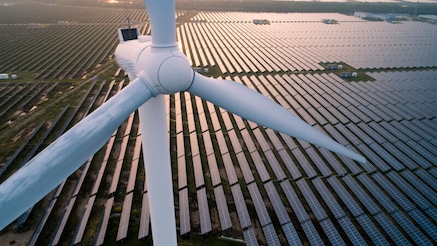5-minute read
The Earth is suffering a health crisis, often referred to as the climate emergency. As humans reshape the world, we have upset the delicate balance of nature. We need to ensure it has clean, oxygen-rich air, unpolluted oceans, and healthy biodiversity, while we work on solutions to restore and retain balance.
Rising surface temperatures impact where humans can live safely
Climate change has been a concern for decades, but NASA recently confirmed that 2020 tied with 2016 for the warmest year since record keeping began in 1880 (see Figure 1). We’ve seen 19 of the warmest ever years occurring since 2000, and with that comes increasingly frequent temperature extremes, high winds, floods and fires. Increased urbanization and deforestation are impacting biodiversity. According to the World Wildlife Found, humans are now overusing the earth’s biocapacity ie its ability to regenerate, by at least 56%. All of these factors lead to higher levels of carbon dioxide and other harmful greenhouse gases (GHG) in the atmosphere, which in turn raises the planet’s average temperatures.

Source: NASA
Figure 1. Global Land-Ocean Temperature Index
National Geographic reports that the world's seas have absorbed more than 90% of the heat from these GHG, and that is taking its toll. Polar ice caps are melting and sea levels around the US have risen six and half inches since the 1950s. They’re expected to rise by another six inches in less than 20 years, and by 10-30 inches by 2100. This will reduce the areas where humans can live and grow food.
This climate emergency has the potential to unleash far greater disruption on the planet than the recent coronavirus pandemic. Its effects will last longer too but, it’s still possible for humanity to exert some control over the situation. And technology sits at the heart of solutions to manage carbon emissions and energy efficiency.
Digital technologies can provide a solution
During the pandemic, the importance of digitalization became clear. Economic growth stalled as societies went into lockdown with people living and working from home instead of commuting and travelling. Remote working, online education, streaming video on demand, and video-based socializing drove people on to fixed and mobile broadband networks, to use digital tools and services. The result was a reduction in air pollution.
According to Dr Ajay Gambhir, a senior research fellow from the Grantham Institute for Climate Change and the Environment, 2020 carbon emissions were down by 20% when comparing April 2020 with April 2019 and 7% on a year on year, as many switched to online working and shopping.
However, these recent declines go against the overall trend. NASA for example reports that carbon dioxide from human activity is increasing more than 250 times faster than it did from natural sources after the last Ice Age (see Figure 2).

Source: NASA
Figure 2. Carbon dioxide levels are increasing
The pandemic also spawned the term ‘The Great Reset’. This term is used by the World Economic Forum and the Financial Times among others, and represents a call to action to create a more sustainable world. One that ensures a fairer, more inclusive society and economy in terms of access to digital services. Importantly it must also protect and rejuvenate the environment, which is the basis for all societies and economies.
Many of the responses to climate change involve intelligent, information-rich tracking and optimization of distributed networks, and driving the circular economy across whole product lifecycles. The same approaches can be used to increase resource efficiency more generally, reducing the threats to biodiversity. Gambhir emphasizes the need for a rethink: “As nations restart their post-pandemic economies and aim to embrace the digital economy further, they need to ensure balance.”
He maintains that energy consumption, in absolute terms, will increase with digitalization. Consequently, economies need to use decarbonized or renewable energy sources and use digital services to enable energy efficiencies and carbon reductions across other industries. “Communications technology, digitalization, and cloud technologies are central to the transition to a zero-emissions economy,” he says. “The avoided emissions that they enable is substantial.”
“Communications technology, digitalization, and cloud technologies are central to the transition to a zero-emissions economy.”
Dr Ajay Gambhir,
Grantham Institute for Climate Change
Mobile networks provide flexibility for greater sustainability
The GSMA’s findings tally with Gambhir’s views. It sees mobile networks in particular, providing additional flexibility in a world of connected people and things in sustainable societies and economies. According to the GSMA and Carbon Trust, mobile networks have a history of driving emissions reduction. In 2018, they enabled a decrease in electric and gas consumption equivalent to the fuel consumed by the UK’s 32.5 million registered passenger cars over a 19-year period.
In its Enablement Effect report, the GSMA estimates that while mobile networks contribute about 0.4% to global emissions, the level of avoided emissions enabled today is a 10:1 positive impact, and this is set to double by 2025.
Mobile technologies drive two forms of enablement: Using IoT to avoid emissions in buildings, transport, manufacturing, and the energy sector, and behavioral changes for example, using more public transport and remote working (see Figure 3).
According to Steven Moore, Head of Climate Action at the GSMA, CSP networks are the basis for decarbonizing a whole range of smart industries, but arguably the industry where it will have the greatest impact is smart energy systems. Its Smart Energy Systems report shows that based on existing and future mobile networks technology, smart energy systems will prevent an overbuild of capacity worth $1.9 trillion per year globally (based on 2020 electricity prices). Compared to today’s energy mix, it will save emissions of 7.7 billion tonnes of CO2 that could account for 23% of global decarbonization. Moore concluded, “Simply put, a digital world is a low carbon world, and mobile networks will be key in delivering that achievement.”
“A digital world is a low carbon world”
Steven Moore,
Head of Climate Action, GSMA
And in terms of enabling further new, sustainable smart energy opportunities, mobile technologies and cloud computing can support distributed energy sources (using drones to inspect remote sites and facilitating the adoption of distributed hydrogen production), virtual power plants (creating digital twins to stimulate new energy scenarios), and supporting vehicle-to-grid technology (that allows exchange of electricity between vehicles and the power grid at optimum times), and smart charging.

Source: GSMA
Figure 3. Mobile communications networks help other industries avoid emissions
Connectivity powered by 5G to unlock sustainable opportunities
Moore sees 5G playing an important role in enabling these sustainable opportunities. “5G technology can leverage its characteristics of high volume, high speed and reliability across large numbers of devices,” he says. “This allows real-time analysis and optimized decisions to be made across the energy ecosystem. This is the new thinking we need to embrace in a zero emissions world.”
Rodrigo Arias, the lead for the World Economic Forum’s (WEF) 5G Global Accelerator Program agrees that 5G has a major role to play in the digital and sustainable economy.
“The speed of change, pervasive scope and impact of the Fourth Industrial Revolution, is completely different from anything we have seen before,” says Arias. However, from a technology perspective, it is the fusion of the new digital technologies that make for exciting possibilities. Arias calls out 5G, the Internet of Things (IoT), artificial intelligence (AI), virtual and augmented reality (AR/VR), and robotics as the basis for innovation, but autonomous vehicles, drones, 3D printing, quantum computing, and bio and nano technology will also produce impactful use cases. He elaborates on the importance of 5G saying, “WEF has studies that show 5G is the global accelerator for many of the use cases in the digital economy.” A WEF report – The Impact of 5G: Creating New Value across Industries and Society – outlines how 5G enables the top five use case categories: IoT, AR/VR, autonomous driving, drones, and robotics.
“5G and connectivity can address each of the UN’s 17 Sustainable Development Goals.”
Rodrigo Arias,
World Economic Forum

Source: United Nations
Figure 4. The United Nation’s 17 Sustainable Development Goals
In terms of 5G’s sustainability, WEF’s research is also compelling. Arias says, “At WEF, we see that 5G and connectivity can address each of the UN’s 17 Sustainable Development Goals (SDGs)" (see Figure 4). “There are five SDGs where 5G has a big impact. These are good health and wellbeing; industry, innovation and infrastructure; responsible consumption and production; sustainable cities and communities, and decent work and economic growth.”
Arias believes that the 5G-enabled benefits that map to those SDGs are wide ranging. They include predictive maintenance, improved worker safety, reduction of OPEX, and the ability to help close the digital divide. He says “5G will also reduce the carbon footprint because many of its standardized features and functions are designed to carry more bits per data per unit of electricity.”
What else needs to happen?
Governments need to take the lead. The Paris Climate Agreement is a landmark agreement to strengthen the global climate effort. It commits countries to undertake nationally determined contributions and establishes mechanisms to hold them accountable and to strengthen ambition in the years ahead. Here, governments have committed to adapt policies to incentivize efforts to reduce carbon emissions. Several jurisdictions put forward new legislation, among them is the European Green Deal – a policy strategy addressing climate and environmental challenges and aiming to make the EU's economy sustainable.
However, to achieve those goals, governments must be supported by the private sector. For example, promoting affordable, renewable energy sources and using recycled and reclaimed materials in buildings and packaging, while the general population should be encouraged to embrace new practices like driving electric cars.
As 5G looks set to play an important role in sustainability, the major ecosystem stakeholders for spectrum, infrastructure, devices, services and security need to cooperate. They need to establish linkages between the social benefits and 5G deployments to attract government support and close the digital divide. Digital inclusion should become foundational to all sustainable development goals.
There are also compelling commercial reasons for business to be more conscious of energy consumption – cost of energy represents significant opex for operators. For example, a recent study by Nokia and Telefónica found that 5G networks are up to 90% more energy efficient per traffic unit than legacy 4G networks, which clearly translates to cost savings.
Nokia’s continuous development of its radio access solutions will help CSPs reduce energy consumption in the most power-hungry area of their networks. Using newer system on chip (SoC) technologies increases performance and energy efficiency and provides more bits per kwh. Additionally, CSPs can use AI powered analytics to digitalize deployments and operations and optimize existing networks.
The reasons for reducing energy consumption and achieving zero emissions are clear, as is the route to success. Governments, businesses and individuals all play a role, and digital technologies provide powerful enabling tools to help reach these goals. Acting together, we can achieve a zero emissions world.

Intrigued by what you’ve read?
Click to learn more from Nokia

Statement
All about zero

Sustainability


